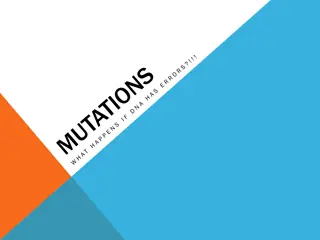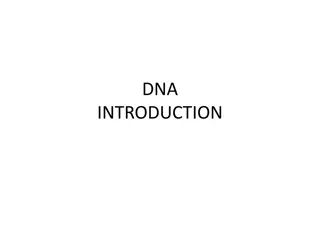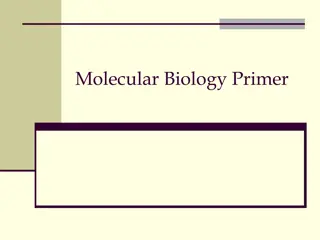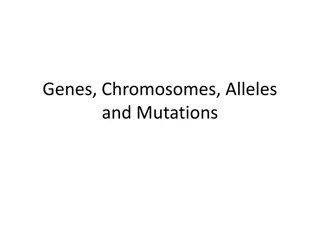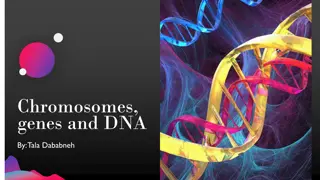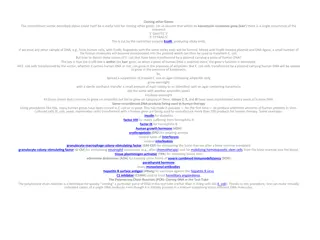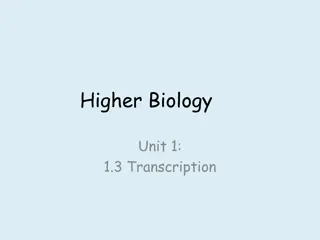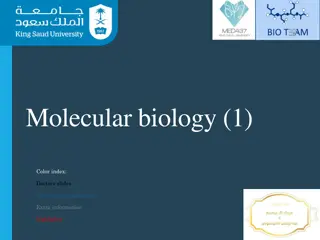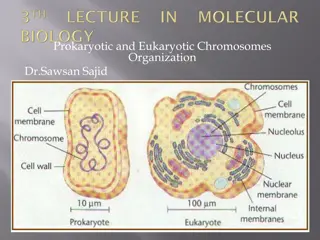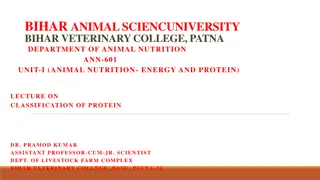Understanding the Basics of Biology - Introduction to DNA, Genes, and Proteins
Explore the fundamental concepts of biology, including the human genome, protein coding genes, central dogma of biology, gene transcription, DNA vs. RNA, and more. Discover how DNA serves as the blueprint for life, how genes are translated into proteins, and the essential processes involved in gene expression.
Download Presentation

Please find below an Image/Link to download the presentation.
The content on the website is provided AS IS for your information and personal use only. It may not be sold, licensed, or shared on other websites without obtaining consent from the author. Download presentation by click this link. If you encounter any issues during the download, it is possible that the publisher has removed the file from their server.
E N D
Presentation Transcript
A Zero-Knowledge Based Introduction to Biology Bo Yoo January 13, 2021
Announcements Website: cs273a.stanford.edu Please sign up for Piazza CA Office Hours: Vote on Piazza by 5PM PST 1/15 Starting the week of 1/18
Announcements Homework 1 will be released next Wednesday (1/20) Due 11:59PM 2/1 (via email) You have 3 late days (can use on homework only) Read the instructions carefully (what files to submit etc.) Post questions on Piazza instead of emailing us Include question number on the subject line 2 Problems Refer to tutorials for clarifications/examples
Human Genome 3 billion base pairs: A,T,G,C Complementary bases: A-T and C-G Full DNA sequence in virtually all cells DNA is the blueprint for life: Cookbook with many recipes for proteins - genes Proteins do most of the work in biology
Protein coding genes In human: set of 20-25K genes that eventually become translated to proteins The number of genes differ by species! Seemingly less complex organisms may have large number of genes E.g. Human (20-25k genes) vs. Rice (51k genes) How are proteins made from DNA?
Gene Transcription DNA -> RNA
DNA (Deoxyribonucleic acid) vs RNA (ribonucleic acid) Deoxyribose in DNA Ribose in RNA
RNA Nucleobases purines Adenine (A) Guanine (G) Uracil (U) Cytosine (C) pyrimidines
Gene Transcription (DNA -> RNA) G A T T A C A . . . 5 3 3 5 C T A A T G T . . .
Gene Transcription (DNA -> RNA) Coding strand (+) G A T T A C A . . . 5 3 3 5 C T A A T G T . . . Template strand (-)
Gene Transcription Coding strand (+) G A T T A C A . . . 5 3 3 5 C T A A T G T . . . Template strand (-)
Gene Transcription Coding strand (+) 5 3 3 5 Template strand (-) Strands are separated (DNA helicase)
Gene Transcription Coding strand (+) 5 3 3 5 Template strand (-) An RNA copy that matches the coding strand (besides T->U) is made from the template strand
Gene Transcription Coding strand (+) G A T T A C A . . . 5 3 3 5 C T A A T G T . . . Template strand (-) G A U U A C A . . . pre-mRNA 5 3
Genes can be found on both strands Coding and template strands are relative to the gene A gene can be on the minus strand (reverse complement) G A T T A C A 5 3 3 5 C T A A T G T U G U A A U C . . . pre-mRNA 5 3 In general genomic sequence are written in the positive strand coordinate
Reverse complement From the positive strand, you can use reverse complement to get what the gene on the minus strand would be Reverse complement: reverse the sequence and change the bases to the complementary bases (i.e., A to T/U, T/U to A, C to G, G to C) Positive strand G A T T A C A . . . . . . A T G G A A C 5 3 pre-mRNA on the positive strand G A U U A C A . . . 5 3 pre-mRNA on the minus strand G U U C C A U . . . 5 3
RNA Processing 5 cap poly(A) tail exon intron mRNA 5 UTR 3 UTR
Gene Translation RNA -> Protein
From RNA to Protein Proteins are long strings of amino acids joined by peptide bonds Translation from RNA sequence to amino acid sequence performed by ribosomes 20 amino acids 3 RNA letters required to specify a single amino acid (codons) o 1 letter can code for up to 4 o 2 letters can code for up to16 o 3 letters can code up to 64
Open Reading Frame (ORF) Open reading frame is a frame that has an ability to be translated (RNA->Protein) Contains a continuous codons starting with a start codon (usually AUG) and end with a stop codon (usually UAA, UAG, UGA) (inclusive). ORF 5 . . . A U U A U G G C C U G G A C U U G A . . . 3 UTR Met Ala Trp Thr Start Codon Stop Codon
Finding ORFs 6 strand/frame combinations +/- strands 3 frames because codons are triplets All of them can contain an open reading frame + strand AATTCATGCGTTTTGACCATCAAATGGCATAACG Reverse complement (change A->T, T->A, C->G, G->C, then reverse the sequence) CGTTATGCCATTTGATGGTCAAAACGCATGAATT - strand
Finding ORFs + strand AATTCATGCGTTTTGACCATCAAATGGCATAACG + strand/frame 0 AAT TCA TGC GTT TTG ACC ATC AAA TGG CAT AAC G + strand/frame 1 A ATT CAT GCG TTT TGA CCA TCA AAT GGC ATA ACG + strand/frame 2 AA TTC ATG CGT TTT GAC CAT CAA ATG GCA TAA CG Same as frame0! + strand/frame 3 AAT TCA TGC GTT TTG ACC ATC AAA TGG CAT AAC G
Finding ORFs + strand AATTCATGCGTTTTGACCATCAAATGGCATAACG + strand/frame 0 AAT TCA TGC GTT TTG ACC ATC AAA TGG CAT AAC G + strand/frame 1 A ATT CAT GCG TTT TGA CCA TCA AAT GGC ATA ACG + strand/frame 2 AA TTC ATG CGT TTT GAC CAT CAA ATG GCA TAA CG Red start codon Blue stop codon
Finding ORFs + strand AATTCATGCGTTTTGACCATCAAATGGCATAACG + strand/frame 0 AAT TCA TGC GTT TTG ACC ATC AAA TGG CAT AAC G + strand/frame 1 A ATT CAT GCG TTT TGA CCA TCA AAT GGC ATA ACG + strand/frame 2 AA TTC ATG CGT TTT GAC CAT CAA ATG GCA TAA CG Red start codon Blue stop codon Highlighted - ORF
Finding ORFs - strand CGTTATGCCATTTGATGGTCAAAACGCATGAATT - strand/frame 0 CGT TAT GCC ATT TGA TGG TCA AAA CGC ATG AAT T - strand/frame 1 C GTT ATG CCA TTT GAT GGT CAA AAC GCA TGA ATT - strand/frame 2 CG TTA TGC CAT TTG ATG GTC AAA ACG CAT GAA TT Red start codon Blue stop codon
Finding ORFs - strand CGTTATGCCATTTGATGGTCAAAACGCATGAATT - strand/frame 0 CGT TAT GCC ATT TGA TGG TCA AAA CGC ATG AAT T - strand/frame 1 C GTT ATG CCA TTT GAT GGT CAA AAC GCA TGA ATT - strand/frame 2 CG TTA TGC CAT TTG ATG GTC AAA ACG CAT GAA TT Red start codon Blue stop codon Highlighted - ORF
Translation The ribosome (a complex of protein and RNA) synthesizes a protein by reading the mRNA in triplets (codons). Each codon is translated to an amino acid.
Gene Structure introns 5 3 promoter exons 3 UTR 5 UTR coding non-coding
Alternative splicing Alternative splicing gives rise to different proteins from the same sequence Use of different exons may result in different start codon, stop codon, and even frames. Different isoforms (functionally similar proteins but do not have identical AA sequence) of the gene Exon 1 Exon 2 Exon 3 CATGA TGCATGT CTAAGTAG Note: Exons don t have to be in triplets
Alternative splicing Exon 1 Exon 2 Exon 3 CATGA TGCATGT CTAAGTAG Exons used (splicing) Exon1, Exon2, Exon3 Full sequence CATGATGCATGTCTAAGTAG Coding sequence C ATG ATG CAT GTC TAA GTAG
Alternative splicing Exon 1 Exon 2 Exon 3 CATGA TGCATGT CTAAGTAG Coding sequence Resulting AA sequence C ATG ATG CAT GTC TAA GTAG MMHV
Alternative splicing Exon 1 Exon 2 Exon 3 CATGA TGCATGT CTAAGTAG Exons used (splicing) Full sequence Coding sequence Resulting AA sequence 1,2,3 CATGATGCATGTCTAAGTAG C ATG ATG CAT GTC TAA GTAG MMHV 1,3 CATGACTAAGTAG C ATG ACT AAG TAG MTK 2,3 TGCATGTCTAAGTAG TGC ATG TCT AAG TAG MSK 1,2 CATGATGCATGT C ATG ATG CAT GT No stop codon found
What does the rest of the genome do? 3 billion base pairs in our genome 1-2% coding (codes for proteins) 10-20% regulatory These regulatory elements give rise to differentiation 1 million Regulatory elements (switches) enable: Precise control for turning genes on/off Diverse cell types (lung, heart, skin) Analogy: Making specific recipes (genes) for a full meal from a large cookbook (genome) at a given time
Gene Expression Regulation Determines when each gene should be expressed Why? Every cell has same DNA but each cell expresses different proteins.
Different Cell Types Subsets of the DNA sequence determine the identity and function of different cells
Regulatory Elements Expression Modulated by Regulatory elements Enhancer, Promoters, Silencers Regulates transcription (DNA -> RNA) of a gene CS analogy: Genes are like variable assignments (a = 7) Regulatory elements are control flow, complex logic
Regulatory Elements Transcription factors (TFs): Proteins that recognize sequence motifs in enhancers, promoters Combinatorial switches that turn genes on/off Complex assists or inhibits formation of the RNA polymerase machinery
Transcription Factor Binding Sites Short, degenerate DNA sequences recognized by particular transcription factors For complex organisms, cooperative binding of multiple transcription factors required to initiate transcription Binding Sequence Logo
Repeats Sequences that repeat many times in the genome About 50% of the genome
Repeats 1. Interspersed Repeats (Transposable elements) Using some unknown mechanic to multiply themselves and move around in the genome
Repeats 2. Simple repeats Every possible motif of mono-, di, tri- and tetranucleotide repeats is vastly overrepresented in the human genome. These are called microsatellites, Longer repeating units are called minisatellites, The real long ones are called satellites. AAAAAAAAA CACACACAC CAACAACAA
Mutations in the Genome Over our lifetime, our DNA replicates trillions of times with the help of DNA polymerase But even polymerase is imperfect , every now and then (roughly 1 in every 100,000 bp), DNA polymerase makes a mistake in replication resulting in mutations There are other sources of mutation, including smoking, sunlight and radiation



